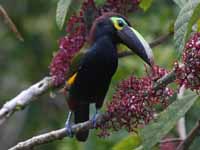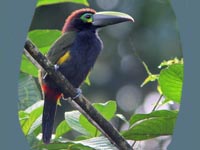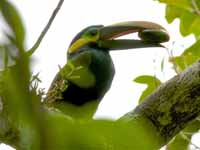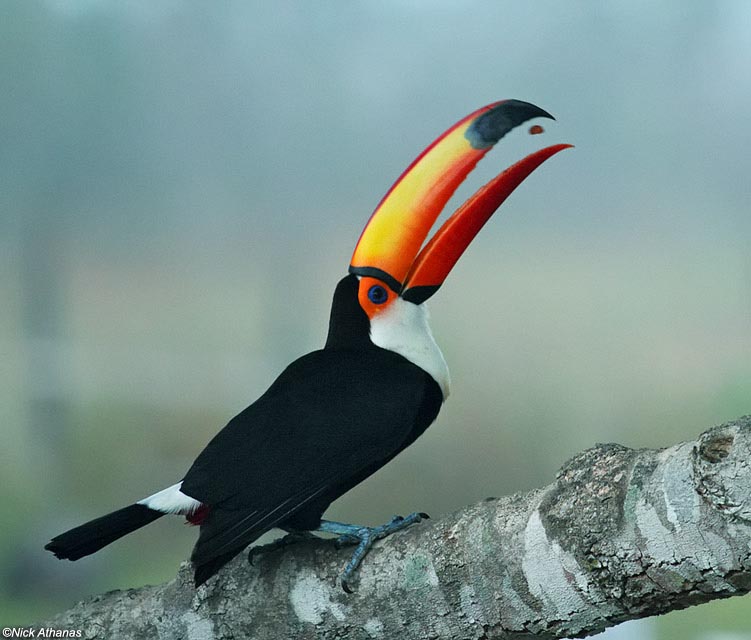The order Piciformes is made up of the woodpecker family Picidae plus 8 other families. Picidae make up about half of the species. In general, the Piciformes are insectivorous, but some exceptions eat mostly fruit. Nearly all Piciformes have parrot-like feet—two toes forward and two back, an arrangement that has obvious advantages for birds that spend much of their time on tree trunks. And most Piciformes do not have down feathers at any age, only true feathers. All nest in cavites.
Family Ramphastidae: Toucans and Allies
Toucans, Toucantes, and Aracaris are birds of Ramphastidae family. They reside in the neotropics (i.e. Southern Mexico, Central, South American, and Caribbean region). The family is most closely related to the American barbets. They are brightly marked and have large, colorful bills which is the hallmark of toucans. Despite its size, the bill it is very light, being composed of bone struts filled with spongy tissue between them. The large bill of the toucan is a highly efficient thermoregulation system. Also, it allows the bird to access food (they eat mostly fruit) unavailable to other birds or save energy by not having to jump to another branch. The bills of female toucans are usually smaller, but similar in colorization. Because their bill is so large, it can be a challenge to transfer the food they are holding in the bill to their mouth. They have developed an rather unique way to get the food into swallowing position - they toss the item into the air and catch it with their open mouth. Or as happens relatively often, they miss the catch and have to get other piece of food!
Not only are the toucans famous for their bills, those bills are one of the best ways to differentiate between toucan species. Almost every species' bill has unique colorization and or markings. For those species where the bill differences are too subtle for differentiation, throat and bib coloration are also helpful as can be bare skin around the eyes.
Toucans range in size 29-63 cm, the smaller ones are call toucanets. The wings are small, as they are forest-dwelling birds that only need to travel short distances. The majority of toucans do not show any sexual dimorphism in their coloration. They make their nests in tree hollows and holes excavated by other animals, but usually enlarged by both toucan parents. Some have also been recorded nesting in holes in earth-banks and terrestrial termite-nests.
They roost in tree cavities at night, often many in a relatively small space. The rear three vertebrae are fused and attached to the spine by a ball and socket joint. Because of this, toucans may snap their tail forwards until it touches the head. This is the posture in which they sleep which allows for dense sharing of roosting cavities.
Toucans, as is true for most members of the Piciformes order, have zygodactyl feet with toes facing in different directions – two toes face forward and two face back. Because toucans spend a large portion of time in the trees, this helps the birds to stay on the branches of the trees and jump from one branch to another. Since toucans only infrequently walk on this ground, this jumping behavior while in trees explains why they have strong legs. In flight they alternates between a burst of rapid flaps with the relatively short, rounded wings, and gliding.
Many of the toucan species are threatened due to a combination deforestation, poaching for pets, and also hunting for food. Hopefully some of these assessments are pessimistic because of insuffient data and some species may exhibit a higher tolerance for habitat modification than is used in mathematical projections of population decline.
Genus Andigena
The mountain-toucans are found in humid highlands in or near the Andes. They are colorful birds with eye-catching plumage. The backs are brownish-olive and they have black caps. They nest in tree cavities located high above the ground.
Toucan, Black-billed Mountain- Andigena nigrirostris
Description: The black-billed mountain-toucan has brownish-olive upperparts including the wings. It has light blue underparts, a white throat, black bill, and yellow orbital skin. The black-billed mountain-toucan is about 50 cm long. It makes bill chattering sounds and has a yelp-like call.
Range: Humid highland forests in the Andes.
Habitat: Columbia, Ecuador, Venezuela.
Diet: Mainly fruits including their seeds. Also insects.
Conservation status: It is listed as Near Threatened because its habitat is declining due to deforestation the population also is declining due to poaching for pets.
Image by: 1) Columbia Travel - Columbia 2) Nick_Athanas - Ecuador 3) Gary_Clark - Ecudaor 4) Felix_Uribe - ColumbiaRange: Humid highland forests in the Andes.
Habitat: Columbia, Ecuador, Venezuela.
Diet: Mainly fruits including their seeds. Also insects.
Conservation status: It is listed as Near Threatened because its habitat is declining due to deforestation the population also is declining due to poaching for pets.
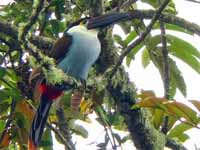
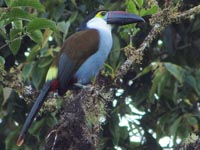
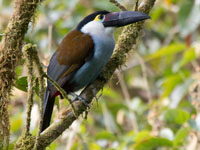
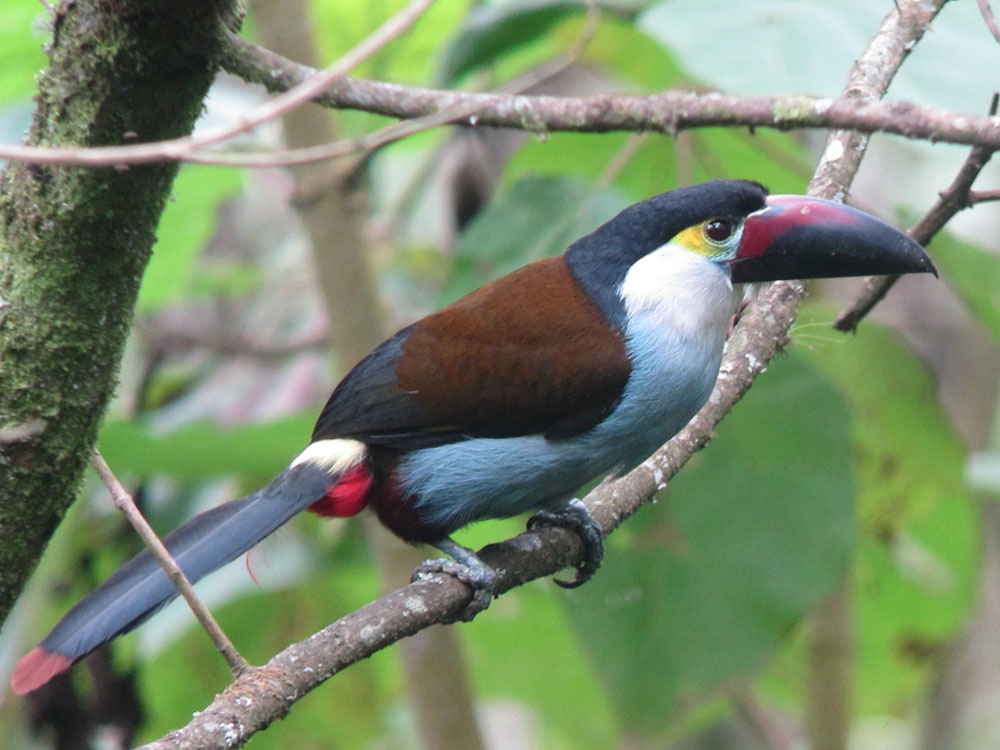
Toucan, grey-breasted Mountain- Andigena hypoglauca
Description: The grey-breasted mountain-toucan has brownish-olive upperparts including the wings. It has a black cap, blue-grey underparts, bluish-grey hind collar, black orbital skin, yellow rump, and red under-tail coverts. The bill has a black band near the base on a yellow-green background. It is red nearer the tip. The grey-breasted mountain-toucan is abiyt 45 cm long.
Range: Columbia, Ecuador, Peru.
Habitat: Humid highland forests.
Diet: Fruits. It is more willing than most largie toucans to leave the canopy and eats raspberries near the ground.
Conservation status: It is listed as Near Threatened because of some deforestation, its small range, and the fear of inbreeding.
Image by: 1) Dominic_Sherony Gossipguy 2, 3) Nick_Athanas - PeruRange: Columbia, Ecuador, Peru.
Habitat: Humid highland forests.
Diet: Fruits. It is more willing than most largie toucans to leave the canopy and eats raspberries near the ground.
Conservation status: It is listed as Near Threatened because of some deforestation, its small range, and the fear of inbreeding.

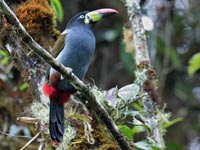
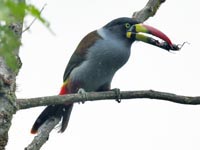
Toucan,_Hooded_Mountain- Andigena cucullata
Description: The hooded mountain-toucan has a chestnut upper-back fading to green and yellow. It has a blackish head (hence the name hooded), bare blue skin around eyes, a blue nape patch, greenish-yellow bill with black tip, and dark blue-green underparts with a chestnut vent. The hooded mountain-toucan is about 50 cm long.
Range: Bolivia, Peru.
Habitat: Highland forests in the Andes.
Diet: Fruits including their seeds.
Conservation status: Least Concern.
Image by: 1, 2) Glenn Bartley - BoliviaRange: Bolivia, Peru.
Habitat: Highland forests in the Andes.
Diet: Fruits including their seeds.
Conservation status: Least Concern.

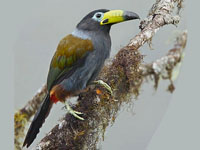
Toucan, Plate-billed Mountain- Andigena laminirostris
Description: The plate-billed mountain-toucan has brownish-olive upperparts, including the wings. It has blue underparts with yellow flanks, a black crown and nape, and black bill with rectangular ivory patch near the base of the upper-bii. It has a yellow rump, yellow skin below the eyes, and yellow-green skin above eyes.
Range: Ecuador, Columbia.
Habitat: Highland forests in the Andes.
Diet: Mainly fruits; also insects and eggs.
Conservation status: It is listed as Near Threatened because its habitat is declining due to deforestation, plus the population also is declining due to poaching for pets. That said, it is still fairly common.
Image by: 1) Ben Tavener - Ecuador 2) Jerry Oldenettel - Ecuador 3) Nick_Athanas - Ecuador 4) Joseph_Boone - EcuadorRange: Ecuador, Columbia.
Habitat: Highland forests in the Andes.
Diet: Mainly fruits; also insects and eggs.
Conservation status: It is listed as Near Threatened because its habitat is declining due to deforestation, plus the population also is declining due to poaching for pets. That said, it is still fairly common.
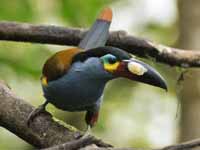
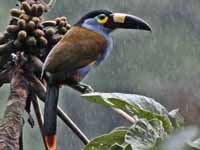
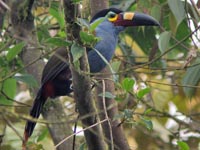

Genus Aulacorhynchus
These relatively small green toucans range from 30 to 45 cm long. They are usually found in moist montane woodlands. Their favorite food is fruit, but insects are also eaten. Most are found in South America along the Andes, but the northern emerald toucanet is found in Mexico and Central America. Their nest cavities are located in a tree, usually high off the ground.
Toucanet, Blue-banded Aulacorhynchus coeruleicinctis
Description: The blue-banded toucanet has mainly green plumage. It has a white supercilium, dark grey orbital skin, grey bill with lighter tip, a white throat, and a a faint blue breast band. Its light colored bill is darker near the base. The blue-banded toucanet is 40 to 44 cm long. It makes bill chattering sounds and has a croak-like call. The similar yellow-browed toucanet has white at base of bill, this toucanet does not.
Range: Southern Ecuador, Bolivia, Peru.
Habitat: Montane forests; prefers dense undergrowth.
Diet: Mainly fruits; also insects.
Conservation status: Least Concern.
Image by: 1) Dave_Smith - Peru 2) Nick_Athanas - Peru 3) thibaudaronsonRange: Southern Ecuador, Bolivia, Peru.
Habitat: Montane forests; prefers dense undergrowth.
Diet: Mainly fruits; also insects.
Conservation status: Least Concern.

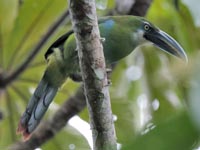

Toucanet,_Chestnut-tipped Aulacorhynchus derbianus
Description: The chestnut-tipped toucanet has mainly green plumage. The bill is black with varying amounts of red and there is a narrow white edge to the base. The tail is red-tipped. The chestnut-tipped toucanet is up to 41 cm long. It makes bill chattering sounds intermixed with a croak-like call.
Range: Southernmost Colombia to Bolivia.
Habitat: Moist montane forests.
Diet: Mainly fruits; also insects.
Conservation status: Least Concern.
Image by: 1) Nick_Athanas - Ecuador 2) Cornell_Univ's_Neotropical_Birds_Online - Paul_Jones in BoliviaRange: Southernmost Colombia to Bolivia.
Habitat: Moist montane forests.
Diet: Mainly fruits; also insects.
Conservation status: Least Concern.
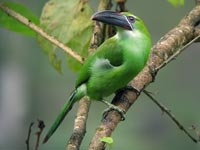
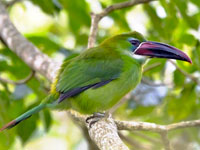
Toucanet, Crimson-rumped Aulacorhynchus haematopygus
Description: The crimson-rumped toucanet has mainly green plumage and a chestnut rump. It has black bill with reddish stripe and white at the base. There is pink bare skin around eye, a green throat, and bluish breast. The crimson-rumped toucanet is up to 45 cm long.
Range: Ecuador, Columbia, Venezuela.
Habitat: Humid Andean forests.
Diet: Mainly fruits; also insects.
Conservation status: Least Concern.
Image by: 1) Dick Daniels - San Diego Zoo 2) Sandy Cole - San Diego Zoo 3) Tobias -
Walsrode Bird Park, Germany 4) Nick_Athanas - EcuadorRange: Ecuador, Columbia, Venezuela.
Habitat: Humid Andean forests.
Diet: Mainly fruits; also insects.
Conservation status: Least Concern.

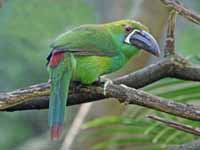
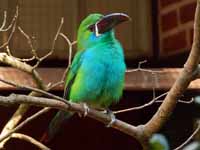

Toucanet, Groove-billed Aulacorhynchus sulcatus
Description: The groove-billed toucanet has mainly green plumage. It has a grooved bill with a thin white border at its base. It has blue below the eyes and dark grey skin around eyes The chin is pale. The yellow-billed toucanet subspecies (A. s. calorhynchus) has mainly yellow on the upper-bii. The groove-billed toucanet is about 35 cm long and weighs 150 to 200 grams. It has croak-like vocalization.
Range: Columbia, Venezuela.
Habitat: Subtropical and tropical montane forests.
Diet: Mainly fruits; also insects.
Conservation status: Least Concern.
Image by: 1) Len_Worthington 2, 4) Barloventomagico - Venezuela 3) Cristobal Minic - VenezuelaRange: Columbia, Venezuela.
Habitat: Subtropical and tropical montane forests.
Diet: Mainly fruits; also insects.
Conservation status: Least Concern.
4) Yellow-billed Toucantet.

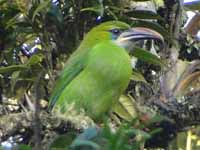
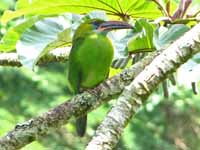
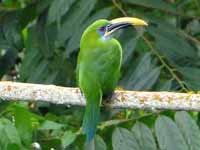
Toucanet, Northern_Emerald Aulacorhynchus prasinus
Description: The northern emerald toucanet has mainly green plumage. Subspecies can be identified by differences in their bills and the coloration around it. Some of the subspecies may be elevated to species. The nominate subspecies has an olive upper manbible, black lower-bill. The blue-throated toucanet (A. p. caeruleogularis) has a yellowish-olive upper-bill , black lower-bill. There is white at the base of bill and the throat is blue. The violet-throated toucanet (A. p. cognatus) has a black bill, white at base of bill, violet chin. The emerald toucanet is 30 to 37 cm long. They have croak-like vocalization and also produce bill-chattering sounds.
Range: Mexico, Central America.
Habitat: Humid montane forests.
Diet: Mainly fruits. Also insects and flowers.
Conservation status: Least Concern.
Image by: 1) Brian Gratwicke - Honduras 2) Amy McAndrews - Mexico 3) Jerry Kirkhart - Belize Zoo Range: Mexico, Central America.
Habitat: Humid montane forests.
Diet: Mainly fruits. Also insects and flowers.
Conservation status: Least Concern.
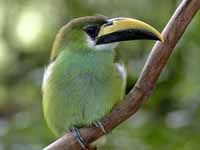

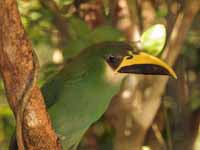
Toucanet, Emerald (Blue-throated) A. p. caeruleogularis also Aulacorhynchus caeruleogulariss Found : Costa Rica, Panama
Image: 1) Doug Greenberg - Costa Rica 2) Scot Ableman - Costa Rica 3) Nick_Athanas - Costa Rica
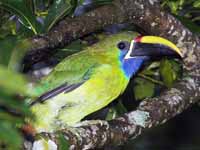
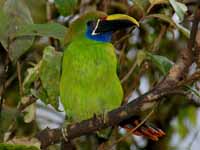

Toucanet,_Southern_Emerald Aulacorhynchus albivitta Found: Soutn America
Description: The southern emerald toucanet, also known as the white-throated toucanet, has mainly green plumage. It has a rufous vent and tail-tip. There us a black and yellow bill and a blackish eye-ring. Throat color varies by subspecies, but is usually white. The southern emerald toucanet is up to 37 cm long. They have a croak-like vocalization. The southern emerald toucanet and northern emerald toucanet were previously conspecific and know as the emerald toucanet.
Range: Along the Andes from Venezuela to Bolivia.
Habitat: Humid montane forests.
Diet: Mainly fruits. Also insects.
Conservation status: Least Concern.
Toucanet,_Andean (A. a. albivitta) Range: Along the Andes from Venezuela to Bolivia.
Habitat: Humid montane forests.
Diet: Mainly fruits. Also insects.
Conservation status: Least Concern.
Image by: 1) Nick Athanas 2) PE_Hart - Ecuador 3) Alejandro_Bayer_Tamayo
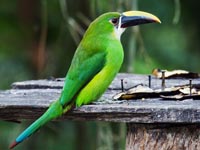
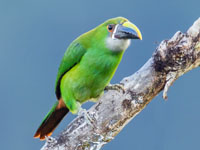
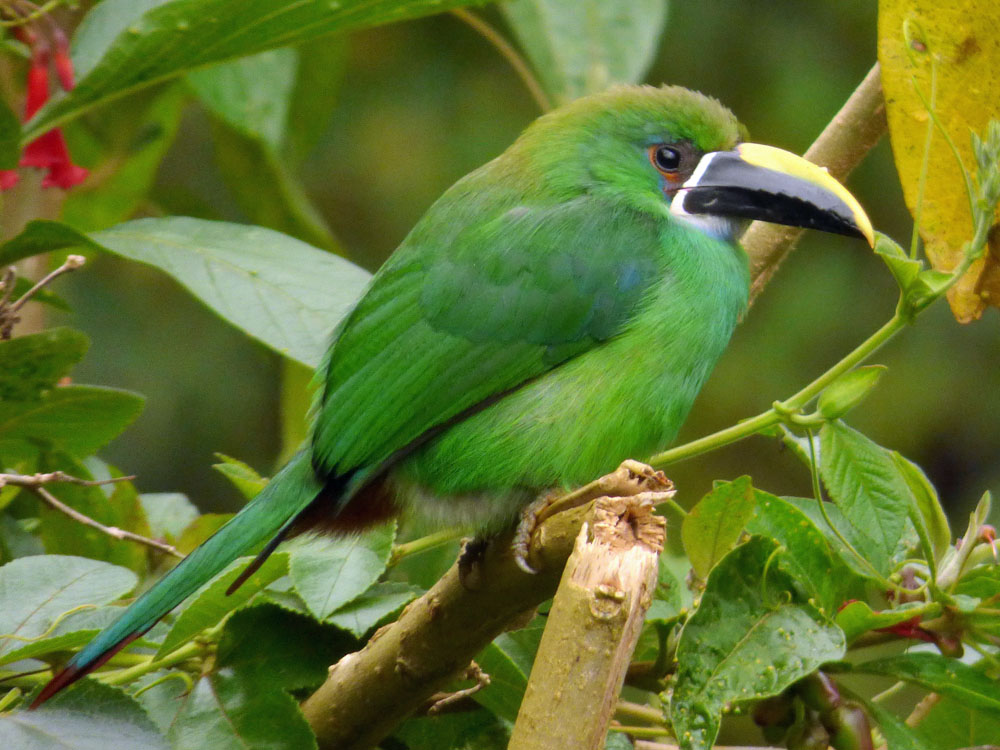
Toucanet,_Black-throated
Image by: 1) Jose Loiza - Ecuador (A. a. cyanolaemus) 2) )Bradley_Hacker - Peru


Toucanet,_grey-throated (A. a. griseigularis)
Image by: 1) Nick Athanas - Columbia 2) Nigel_Voaden - Columbia
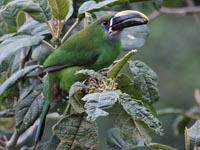
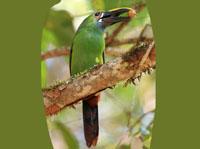
Toucanet, Santa Marta (A. a. lautus)
Image by: 1) Bill_Maynard - Columbia 2) Nick Athana - Columbias 3) Brendan_Ryan - Columbia


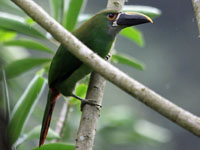
Toucanet, Yellow-browed Aulacorhynchus huallagae
Description: The yellow-browed toucanet has mainly green plumage; It has a yellow supercilium and yellow under-tail coverts. There is a white throat and white at base of bill. The bill black varies to light grey towards tip. The pale green underparts have a light blue breast band. The similar blue-banded toucanet does not have white at the base of the bill. The yellow-browed toucanet is about 44 cm long. It has a croak-like vocalization.
Range: Peru.
Habitat: Humid forests growing on the east Andean slope.
Diet: It probably feeds mainly on fruit, but also insects.
Conservation status: It is listed as Endangered because it appears to be in a very restricted range and little is known about its population. The area is roadless and thus hard to get to, perhaps the popluation is larger than presently known.
Image by: GossipguyRange: Peru.
Habitat: Humid forests growing on the east Andean slope.
Diet: It probably feeds mainly on fruit, but also insects.
Conservation status: It is listed as Endangered because it appears to be in a very restricted range and little is known about its population. The area is roadless and thus hard to get to, perhaps the popluation is larger than presently known.
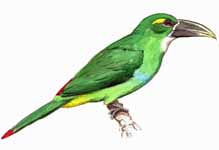
Genus Pteroglossus
The aracaris are brightly colored and have large bills that can often an identifying feature. Most aracaris, unlike other toucans, have one or more colored belts on their underparts. That is usually their best identifiable feature. They are 29 to 48 cm long.
Aracari, Black-necked Pteroglossus aracari Found: South America
Description: The black-necked aracari has dark brown upperparts and a black hood. It has an ivory upper-bill and a black lower-bill. The underparts are yellow with a red band. The black-necked aracari is about 45 cm long.
Range: Northeast South America and eastern Brazil.
Habitat: Moist lowland forests and heavily degraded former forest.
Diet: Mainly fruits. Also insects.
Conservation status: Least Concern.
Image by: 1) Andrew Newberry 2) Sharib4rd - Jacksonville Zoo 3) Barloventomagico - Caracas Zoo 1) Nick_Athanas - VenezuelaRange: Northeast South America and eastern Brazil.
Habitat: Moist lowland forests and heavily degraded former forest.
Diet: Mainly fruits. Also insects.
Conservation status: Least Concern.
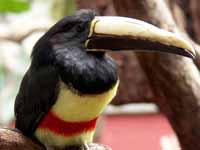
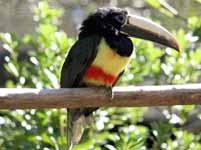
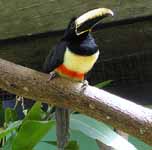
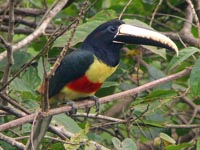
Aracari, Chestnut-eared Pteroglossus castanotis Found: South America
Description: The chestnut-eared aracari has a black head (the dark chestnut colored "ears" usually not visible), black throat, black bib, and yellow underparts with a red belt. Some subspecies have a chestnut colored head. The chestnut-eared aracari is about 45 cm long. The blue skin around the yellow eyes plus the more distinct bill differentiate it from the black-necked aracari.
Range: Western and central South America.
Habitat: Humid forests near water, forest edges.
Diet: Mainly fruits. Also insect, flower nectar, nuts.
Conservation status: Least Concern.
Image by: 1) en VPrat 2) Jose Cajacuri 3) Nick_Athanas - Brazil 4) Jerry_Oldenettel - EcuadorRange: Western and central South America.
Habitat: Humid forests near water, forest edges.
Diet: Mainly fruits. Also insect, flower nectar, nuts.
Conservation status: Least Concern.

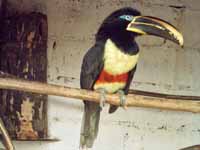
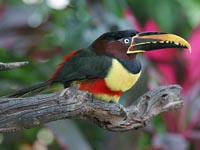
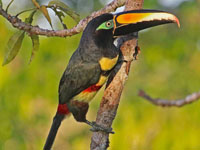
Aracari, Collared Pteroglossus torquatus
Description: The collared aracari has blackish-green upperparts. It has a difficult to see reddish collar on the hind-neck. The upper-bill has yellow tooth-like marking and a dark tip; the lower-bill is black; there is a white border to the base of the bill. It has a black hood and yellow eyes. The underparts are yellow with a dark belt and often black patch on the breast. This northern most aracari is up to 48 cm long. The pale-billed aracari is sometimes considered a subspecies of the collared aracari.
Range: Mexico, Central America, northern South America.
Habitat: Lowland forests and more open woodlands.
Diet: Mainly fruits. Also insects, lizards, eggs.
Conservation status: Least Concern.
Image by: 1) Dennis Jarvis - Belize 2) Jerry Oldenettel - Costa Rica 3) Nick_AthanasRange: Mexico, Central America, northern South America.
Habitat: Lowland forests and more open woodlands.
Diet: Mainly fruits. Also insects, lizards, eggs.
Conservation status: Least Concern.
4) Pale-billed subspecies
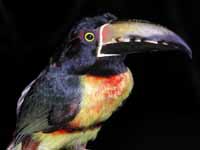
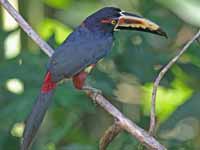
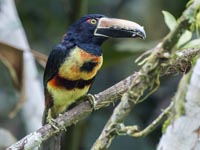
Aracari, Curl-crested Pteroglossus beauharnaisii
Description: The curl-crested aracari has dark upperparts with a red cape and rump. It has black curly head with white freckles, white face with small black freckles, yellowish-white throat with possible freckles, and yellow underparts with a red belt. The curl-crested aracari is 40 to 45 cm long.
Range: South-western section of the Amazon Basin in Peru, Bolivia, and Brazil.
Habitat: Tropical moist lowland forests.
Diet: Mainly fruits. Also chicks of non-toucan birds.
Conservation status: Least Concern.
Image by: 1) Lonnie Huffman - Columbia, South Carolina Zoo 2, 3, 4) Dick Daniels - San Diego Zoo Range: South-western section of the Amazon Basin in Peru, Bolivia, and Brazil.
Habitat: Tropical moist lowland forests.
Diet: Mainly fruits. Also chicks of non-toucan birds.
Conservation status: Least Concern.
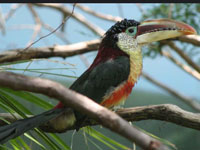

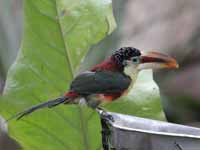

Aracari, Fiery-billed Pteroglossus frantzii
Description: The fiery-billed aracari has dark green upperparts with a red median stripe on the lower back and also a red rump. It has a black head, an orange-red upper-bii, blackish lower-bill, and a black throat. The breast is yellow with a dark spot and red belt; the belly is yellow. The fiery-billed aracari is about 43 cm long and weighs 250 grams. It is similar to the pale-mandibled aracari. which has a black belt.
Range: Costa Rica, Panama.
Habitat: Wet lowland forests and woodlands.
Diet: Mainly fruits; also insects, lizards, eggs, and other small prey.
Conservation status: Least Concern.
Image by: 1) Andrew Mace 2) Alison Le Garec - Costa Rica 3) Charlie Westerinen - south central Costa Rica 4) Nick_Athanas - Costa RicaRange: Costa Rica, Panama.
Habitat: Wet lowland forests and woodlands.
Diet: Mainly fruits; also insects, lizards, eggs, and other small prey.
Conservation status: Least Concern.

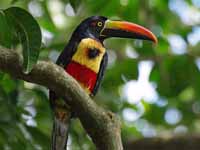
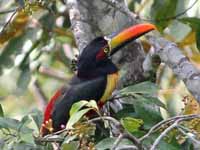
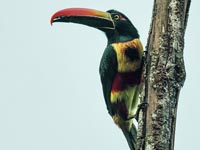
Aracari, Green Pteroglossus viridis
Description: The green aracari has a dark green back with a red median stripe that reaches the rump. The male has a dark head while the female has reddish-brown mixed in. The large striking bill has yellow above, black below, and red in the middle. The yellowish underparts lack a belt which is unusual for an aracari. This small aracari is about 35 cm long.
Range: Northeast South America.
Habitat: Lowland forests.
Diet: Mainly fruits; also insects.
Conservation status: Least Concern.
Image by: 1) ucumari_photography 2) Tanalso Juuyoh 3) Nick_Athanas - Venezuela 4) Eric_Savage - Bronx ZooRange: Northeast South America.
Habitat: Lowland forests.
Diet: Mainly fruits; also insects.
Conservation status: Least Concern.
1) Female 2 - 4) Male

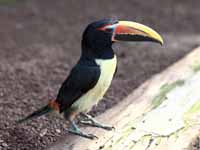
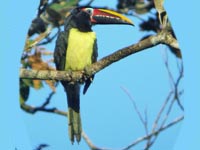
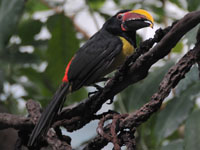
Aracari, Ivory-billed Pteroglossus azara
Description: The ivory-billed aracari has an ivory colored bill, brown upperparts, a dark brown head, red upper-breast band, black lower-breast band, yellow belly, and red rump.The ivory-billed aracari is up to 45 cm long.
Range: Bolivia, Brazil, Colombia, Ecuador, Peru, and Venezuela.
Habitat: Moist lowland forests.
Diet: Mainly fruits; also insects.
Conservation status: Least Concern.
Image by: 1) digitalART2 - Philadelphia Mcneil Avian Center 2, 3, 4)
Dick Daniels - San Diego ZooRange: Bolivia, Brazil, Colombia, Ecuador, Peru, and Venezuela.
Habitat: Moist lowland forests.
Diet: Mainly fruits; also insects.
Conservation status: Least Concern.

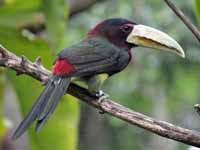
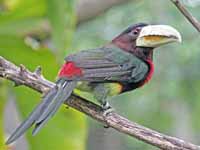

Aracari, Lettered Pteroglossus inscriptus
Description: The lettered aracari has mainly dark green upperparts with a red rump. It has a black head (male) or dark brown (female), and blue bare skin around the eyes. One subspecies has plain yellowish upper-bill and dark lower-bill. Another subspecies has mainly a yellow bill with dark "letters"; the lower-bill has some black near the base. The underparts are yellow and the rump is red. The lettered aracari is relatively small at 29 cm long.
Range: Bolivia, Brazil, Colombia, Ecuador, and Peru.
Habitat: Lowland forests and heavily disturbed former forests.
Diet: Mainly fruit; also insects and some small vertebrates.
Conservation status: Least Concern.
Image by: 1) Ian_Davies - Columbia 2) Bart van Dorp - Brazil 3) Nick_Athana - Columbia 4) Eric_Gropp - PeruRange: Bolivia, Brazil, Colombia, Ecuador, and Peru.
Habitat: Lowland forests and heavily disturbed former forests.
Diet: Mainly fruit; also insects and some small vertebrates.
Conservation status: Least Concern.




Aracari, Many-banded Pteroglossus pluricinctus
Description: The many-banded aracari has dark green upperparts. There is blue bare skin around the eyes. Ii has a dark green upper-breast and the rest of the yellow underparts have two reddish bands. It has a black hood, black lower-bill, and a yellowish upper-bill with a black top. The many-banded aracari is about 45 cm long.
Range: Brazil, Colombia, Ecuador, Peru, and Venezuela.
Habitat: Humid forests below 1000 m.
Diet: Fruits and probably some insects.
Conservation status: Least Concern.
Image by: 1) Patty McGann 2) Carol Foil - Ecuador 3) Nick_Athana -EcuadorRange: Brazil, Colombia, Ecuador, Peru, and Venezuela.
Habitat: Humid forests below 1000 m.
Diet: Fruits and probably some insects.
Conservation status: Least Concern.
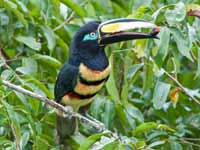

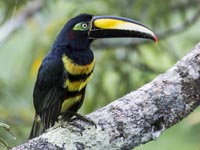
Aracari, Pale-billed Pteroglossus erythropygius
Description: The pale-billed aracari, also known as the pale-mandibled aracari, has dark green upperparts with a red rump. It has red skin around the eyes and a mainly pale bill. The underparts are yellow with a black breast spot and black belt. It is up to 48 cm long. The pale-billed aracari is sometimes considered to be a subspecies of the collared aracari. It is similar to the fiery-billed Aracari which has a black belt.
Range: Western Ecuador and Peru.
Habitat: Lowland forests and more open woodlands.
Diet: Mainly fruits. Also insects.
Conservation status: Least Concern.
Image by: 1) Mark Watson - Ecuador 2) gailhampshire - Ecuador 3) Nick Athanas Range: Western Ecuador and Peru.
Habitat: Lowland forests and more open woodlands.
Diet: Mainly fruits. Also insects.
Conservation status: Least Concern.
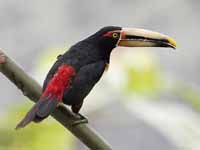
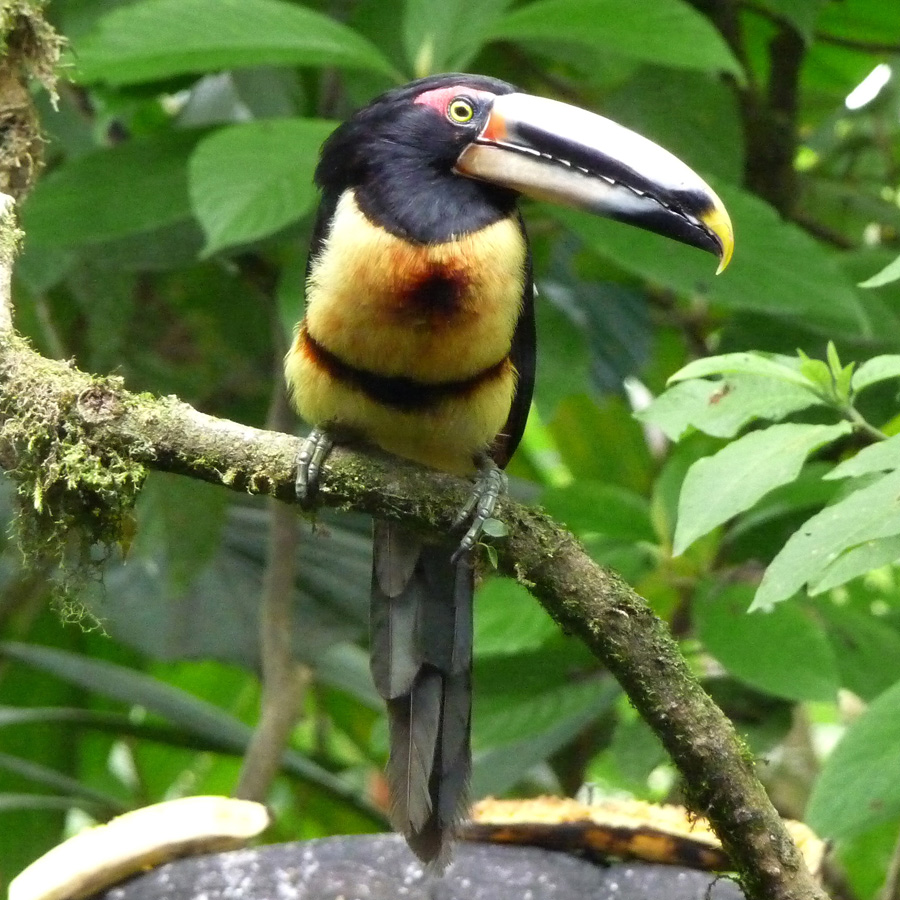
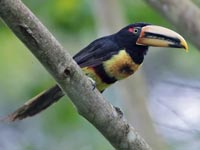 <
<Aracari, Red-necked Pteroglossus bitorquatus
Description: The red-necked aracari has a red upper-back, nape, and rump. The head is black; the rest of the upperparts are dark green. The throat is black with a white narrow frontal collar. It has a red breast which is bordered above by a narrow yellow collar. The belly is yellow. The red-necked aracari is about 36 cm long.
Range: Bolivia, Brazil.
Habitat: Moist lowland forests and heavily degraded former forest.
Diet: Fruits; probably also insects.
Conservation status: It is listed as Near Threatened as because of ongoing and projected deforestation. It does show some tolerance for more open areas, perhaps this status listing is pessimistic.
Image by: 1) Jorge Montejo - Brazil 2) Nick_Athanas - Brazil 3) Cornell_Univ's_Neotropical_Birds_Online - Renato_RizzaroRange: Bolivia, Brazil.
Habitat: Moist lowland forests and heavily degraded former forest.
Diet: Fruits; probably also insects.
Conservation status: It is listed as Near Threatened as because of ongoing and projected deforestation. It does show some tolerance for more open areas, perhaps this status listing is pessimistic.
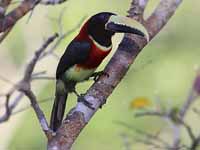


Toucanet, Saffron Pteroglossus bailloni
Description: The saffron toucanet has orange-yellow (saffron) head and shoulders. It has an olive back and tail, greenish-yellow underparts, red rump, red ocular skin, yellow eyes, and a greenish-yellow bill with some red near the base. The saffron toucanet is about 37 cm long.
Range: Argentina, Brazil, Paraguay.
Habitat: Forest, forest edges, woodlands.
Diet: Mainly fruits; also insects and chicks.
Conservation status: They are listed as near threatened. Part of their problem is that they are one of the few dispersers of large seeds so as the bird's population declines their food supply becomes more restricted which is a vicious circle.
Image by: 1, 2) Claudio Timm 3) Rick Elis Simpson 3) Nick_Athanas - BrazilRange: Argentina, Brazil, Paraguay.
Habitat: Forest, forest edges, woodlands.
Diet: Mainly fruits; also insects and chicks.
Conservation status: They are listed as near threatened. Part of their problem is that they are one of the few dispersers of large seeds so as the bird's population declines their food supply becomes more restricted which is a vicious circle.
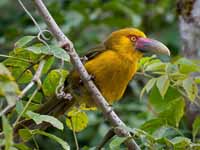

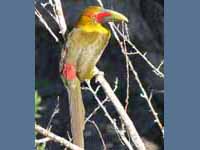
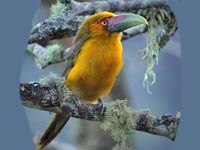
Genus Ramphastos
These toucans all have black wings, tails, and thighs. They mainly eat fruit but will eat insects and small prey. These toucans, ranging from 52 to 69 cm, are larger than the toucanets.
Toucan, Channel-billed Ramphastos vitellinusFound: South America
Description: The channel-billed toucan has dark upperparts, crown, and nape. It has a white face and white bib with a yellow area,and a black belly, There is a red breast-belly border. It has blue feet and blue skin around the eyes. The bill has mainly black or reddish-brown color, a blue base of the lower-bill and a blue or yellow base of the upper-bii. The channel-billed toucan is about 48 cm long with a weight of 360 grams. The similar white-throated toucan.is almost identical except it has a larger bill.
Range: Northern and central South America plus the coastal forest of southeastern Brazil.
Habitat: Mainly lowland forest and woodlands.
Diet: Mainly fruits, but also insects, small reptiles, eggs and frogs.
Conservation status: They are listed as Vulnerable because of habitat loss and they are hunted for food.
Image by: 1) Arjan Haverkamp 2) Alfonso Jr 3) Kevin Watts 4) Luis_SanchesRange: Northern and central South America plus the coastal forest of southeastern Brazil.
Habitat: Mainly lowland forest and woodlands.
Diet: Mainly fruits, but also insects, small reptiles, eggs and frogs.
Conservation status: They are listed as Vulnerable because of habitat loss and they are hunted for food.
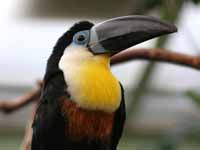

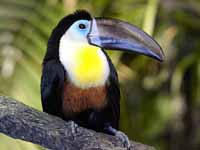
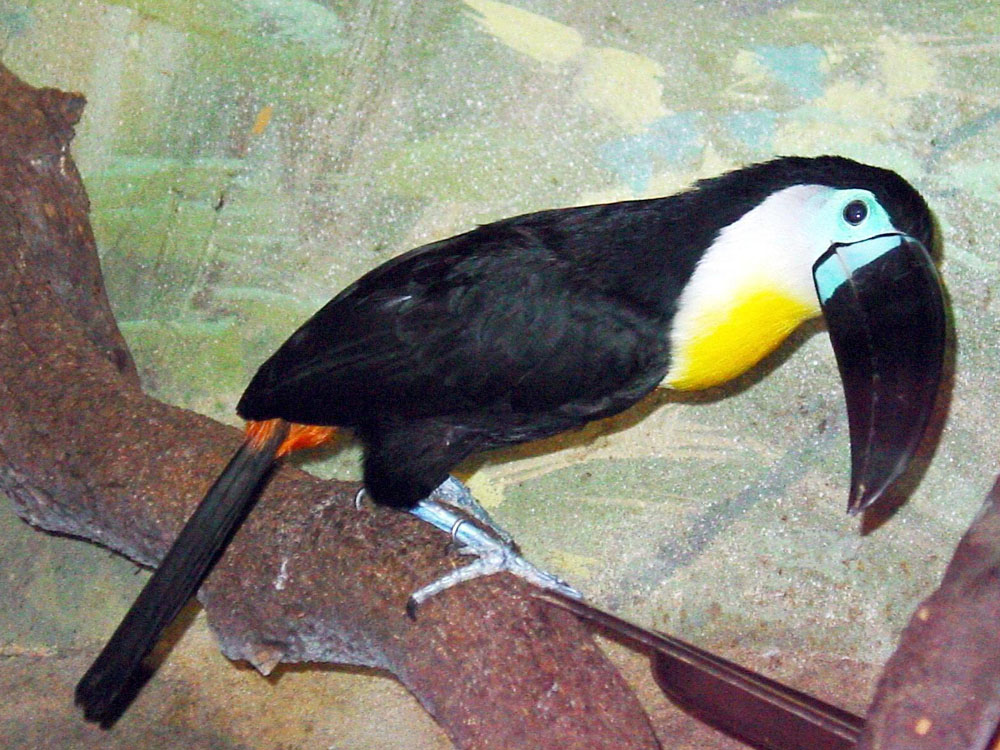
Toucan,_Choco Ramphastos brevis
Description: The Choco toucan has mainly black plumage plus a yellow face and bib, white upper-tail coverts, red under-tail coverts, a yellow upper bill, and black lower bill. The yellow-throated toucan is about 47 cm long. It is similar to the chestnut-mandibiled toucan, a subspecies of the yellow-throated toucan, which is found in the same range. On the average, the Choco toucan is considerably smaller. The best way to tell them apart is by their voice; croaking in the Choco, yelping in the chestnut-mandibled.
Range: Pacific slope of Andes in Columbia and Ecuador.
Habitat: Lowland Choco forest up to about 1500 meters. Also pastures and plantations with fruiting trees.
Diet: Fruits; also insects.
Conservation status: Least Concern.
Image by: 1) Nick_Athanas 2) Patty_McGann 3) Dave_Wendelken - EcuadorRange: Pacific slope of Andes in Columbia and Ecuador.
Habitat: Lowland Choco forest up to about 1500 meters. Also pastures and plantations with fruiting trees.
Diet: Fruits; also insects.
Conservation status: Least Concern.
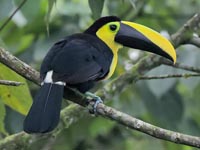
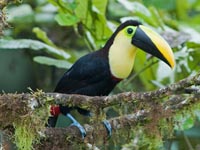

Toucan, Keel-billed Ramphastos sulfuratus
Description: The keel-billed toucan has mainly black plumage. Its name refers to its very large bill which is mainly light green with a red tip and orange sides. Due to this multicolored bill, another name for this species is the rainbow-billed toucan. It has a yellow face and bib, white uppertail coverts, red rump,and blue legs. Their call is a croaking sound. The keel-billed toucan is about 45 to 55 cm long.
Range: Southern Mexico to Columbia and Venezuela.
Habitat: Old growth rainforest, woodlands, plantations. Usually found in the canopy.
Diet: Mainly fruits. Also insects, small vertebrates, eggs, chicks.
Conservation status: It is listed as Near Threatened but it has a large range and population, so perhaps the listing should be revisited.
Image by: 1) Andy_Morffew - Costa Rica 2) Donar Reiskoffer - La Pumas Zoo, Guanacaste, Costa Rica 3, 4) Dick Daniels - National Aviary Range: Southern Mexico to Columbia and Venezuela.
Habitat: Old growth rainforest, woodlands, plantations. Usually found in the canopy.
Diet: Mainly fruits. Also insects, small vertebrates, eggs, chicks.
Conservation status: It is listed as Near Threatened but it has a large range and population, so perhaps the listing should be revisited.
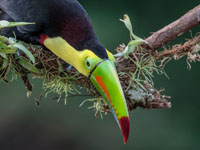
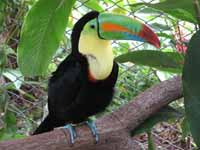
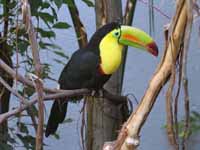

Toucan, Red-breasted Ramphastos dicolorus
Description: The red-breasted toucan, also known as the green-billed toucan, has black upperparts. It has a yellow throat and upper-breast. The lower-breast, belly, and skin around eye are red. It has a green bill with black near the base. At 42 to 48 cm long, the red-breasted toucan is the smallest of the genus.
Range: Southeast Brazil, Bolivia, eastern Paraguay and north-eastern Argentina.
Habitat: A variety of habitats from forests to treed savanna.
Diet: Fruits; also insects.
Conservation status: Least Concern.
Image by: 1) George Shepherd 2) Gareth Christopher 3) Dario
Sanches - Brazil 4) Jairmoreirafotografia - BrazilRange: Southeast Brazil, Bolivia, eastern Paraguay and north-eastern Argentina.
Habitat: A variety of habitats from forests to treed savanna.
Diet: Fruits; also insects.
Conservation status: Least Concern.
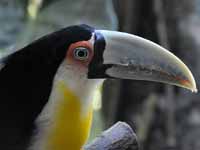
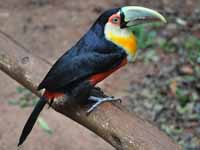
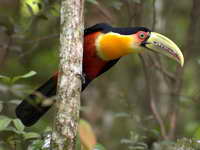
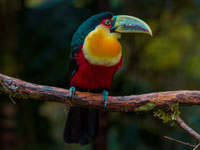
Toucan, Toco Ramphastos toco
Description: The toco toucan has black upperparts. It has white throat, white upper breast, black lower breast, black belly, yellow-orange bill with black base, and large black spot near its tip. The toco toucan is 55 to 65 cm long and weighs 500 to 875 grams which makes it the largest toucan.
Range: Large part of central and eastern South America.
Habitat: Woodland, savanna and other open habitats with scattered tree.
Diet: Mainly fruits. Also insects, small vertebrates, eggs, chicks.
Conservation status: Least Concern.
Image by: 1) Martha_de_Jong-Lantink 2) Daph Chloe 3) Dick Daniels - Bronx Zoo Range: Large part of central and eastern South America.
Habitat: Woodland, savanna and other open habitats with scattered tree.
Diet: Mainly fruits. Also insects, small vertebrates, eggs, chicks.
Conservation status: Least Concern.
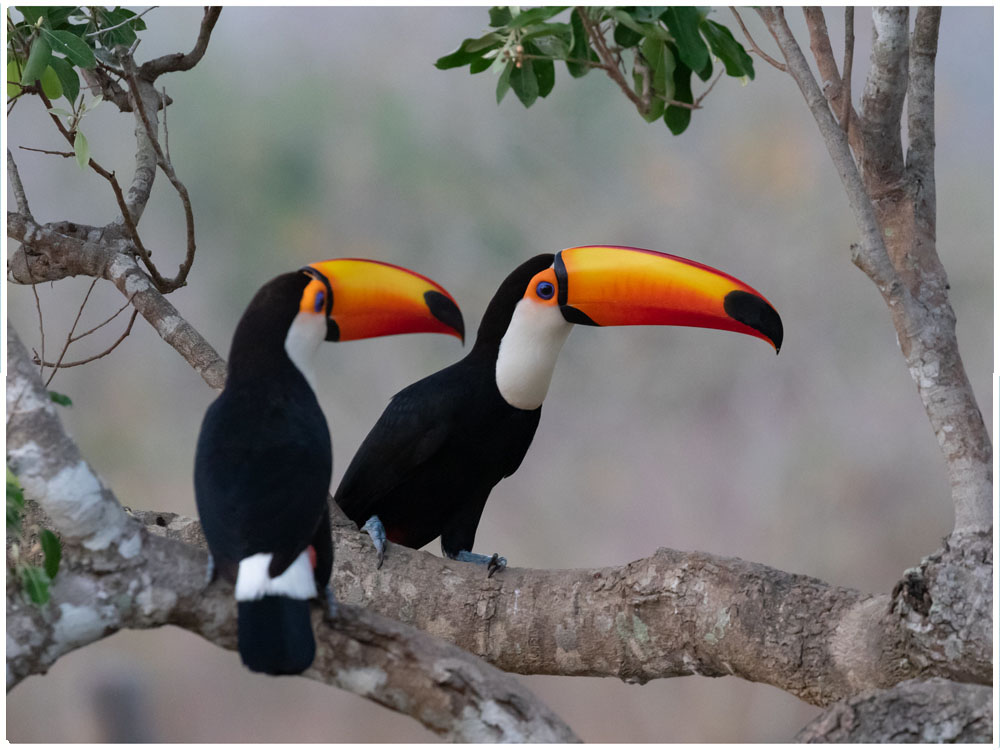

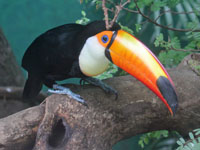
Toucan, White-throated Ramphastos tucanus
Description: The white-throated toucan has black upperparts, crown, and nape. It has a white face and bib, black belly, red breast-belly border, blue feet, and blue skin around the eyes. The bill has mainly black or reddish-brown color, a blue base of the lower-bill, a yellow base of upper-bii, and yellow along the top border of the bill. The white-throated toucan is 50 to 69 cm long. The almost identical channel-billed toucan has a proportially larger bill.
Range: Northern and central South America.
Habitat: Forests, their edges and clearings, woodlands, open areas with trees available.
Diet: Mainly fruits. Also insects, small vertebrates, eggs, chicks.
Conservation status: It is listed as Vulnerable based on assumed future deforestation and the fact thqat it is poached for pets.
Image by: 1) Cburnett 2) Anagoria - Venezuela 3) Nick_Athanas- VenezuelaRange: Northern and central South America.
Habitat: Forests, their edges and clearings, woodlands, open areas with trees available.
Diet: Mainly fruits. Also insects, small vertebrates, eggs, chicks.
Conservation status: It is listed as Vulnerable based on assumed future deforestation and the fact thqat it is poached for pets.
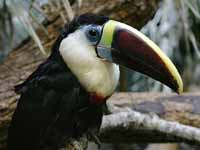


Toucan,_Yellow-throated Ramphastos ambiguus
Description: The yellow-throated toucan is sometimes considered as 2 separate species: the black-mandibled toucan (R. a. ambiguus and R.a. abbreviatus) and the chestnut-mandibled toucan (R, a, swainsoni). Except for the color of the lower bill, they two are essentially identical in appearance. They mainly have black plumage plus a yellow face and bib, a creamy rump, and a yellow upper bill. The yellow-throated toucan is from 47 to 60 cm in length which makes it one of the largest toucans.
Range: The chestnut-mandible toucan is from Honduras to west Ecuador. The black-mandibled toucan is found from Venezuela to Columbia to Peru.
Habitat: Plains to forests, preferring the edges and canopy. Varies in altitude from 100 to 2400 m.
Diet: Mainly fruits; also insects, lizards, eggs, and chicks.
Conservation status: It is listed as Near Threatened because of the fear that deforestion will diminish its population which is currently quite large.
Image by: Becky_Matsubara - Costa Rica 3) Dick - Summit Zoo, Panama 4) Chuck624 - Costa Rica Range: The chestnut-mandible toucan is from Honduras to west Ecuador. The black-mandibled toucan is found from Venezuela to Columbia to Peru.
Habitat: Plains to forests, preferring the edges and canopy. Varies in altitude from 100 to 2400 m.
Diet: Mainly fruits; also insects, lizards, eggs, and chicks.
Conservation status: It is listed as Near Threatened because of the fear that deforestion will diminish its population which is currently quite large.
1) Black-mandibled Toucan plains to tropical and subtropical forest2 - 4) Chestnut-mandibled Toucan

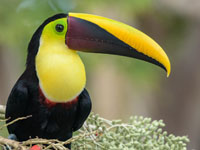

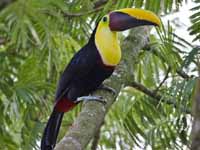
Genus Selenidera
These toucanets are found mainly in rainforests of South America with the yellow-eared toucanet also found in Central America. All of the species have green upperparts and red under-tail coverts. All males have a black cap, nape, throat, and breast. They also have an orange or yellow stripe behind the eye. Females resemble the males, but may have black replaced by reddish-brown or grey in the case of the Guianan toucanet. The toucanets range from 31 cm to about 41.
Toucanet_ Golden-collared Selenidera reinwardtii
Description: The golden-collared toucanet has a green back and tail. It has yellow ear-coverts extending to its golden hind-collar. The bill is mainly black with a brownish-red base or a bluish-grey base. The male has a black cap and black underparts with yellow flanks. The female has a chestnut cap and chestnut underparts with yellow flanks. The golden-collared toucanet is about 34 cm long.
Range: Western Amazon rainforest.
Habitat: Forest, forest edges. Prefers dry areas and ridges.
Diet: Fruits; also insects.
Conservation status: Least Concern.
Image by: 1) Nick_Athanas - Ecuador 2) Hector Bottai - Brazil 3) Jim Davies 4) Joao_Quental in PeruRange: Western Amazon rainforest.
Habitat: Forest, forest edges. Prefers dry areas and ridges.
Diet: Fruits; also insects.
Conservation status: Least Concern.
1, 2) Female 3, 4) Male
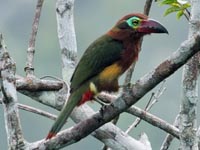
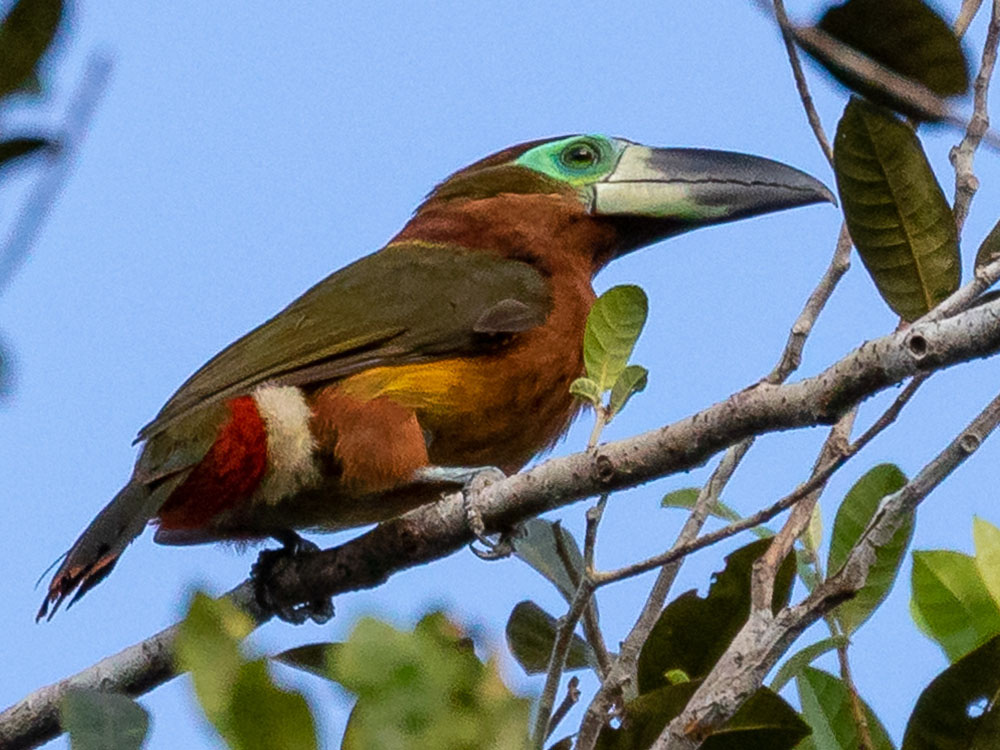
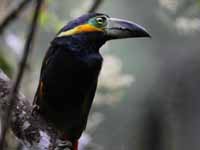
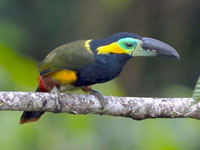
Toucanet, Gould's Selenidera gouldii Found: South America
Description: The Gould's toucanet has green upperparts, a black cap, and a black nape. It has green and yellow orbital skin. The bill has the front third green; the rest of the upper-bill is black with some grey at its base. The lower bill has much of the black replaced by grey. The male has a large golden tuft which originates at the ear-coverts. He has black underparts. The female has negligible ear tuffs and chestnut underparts. The Gould's toucanet is about 33 cm long.
Range: Southeastern Amazon rainforest.
Habitat: Various types forests and woodland, but prefers tall trees.
Diet: Mainly fruits. Probably insects, small vertibratres, chicks.
Conservation status: Least Concern.
Image by: 1, 2) Alexander_Lees 3) TuftedearRange: Southeastern Amazon rainforest.
Habitat: Various types forests and woodland, but prefers tall trees.
Diet: Mainly fruits. Probably insects, small vertibratres, chicks.
Conservation status: Least Concern.
1) Female 2, 3) Male


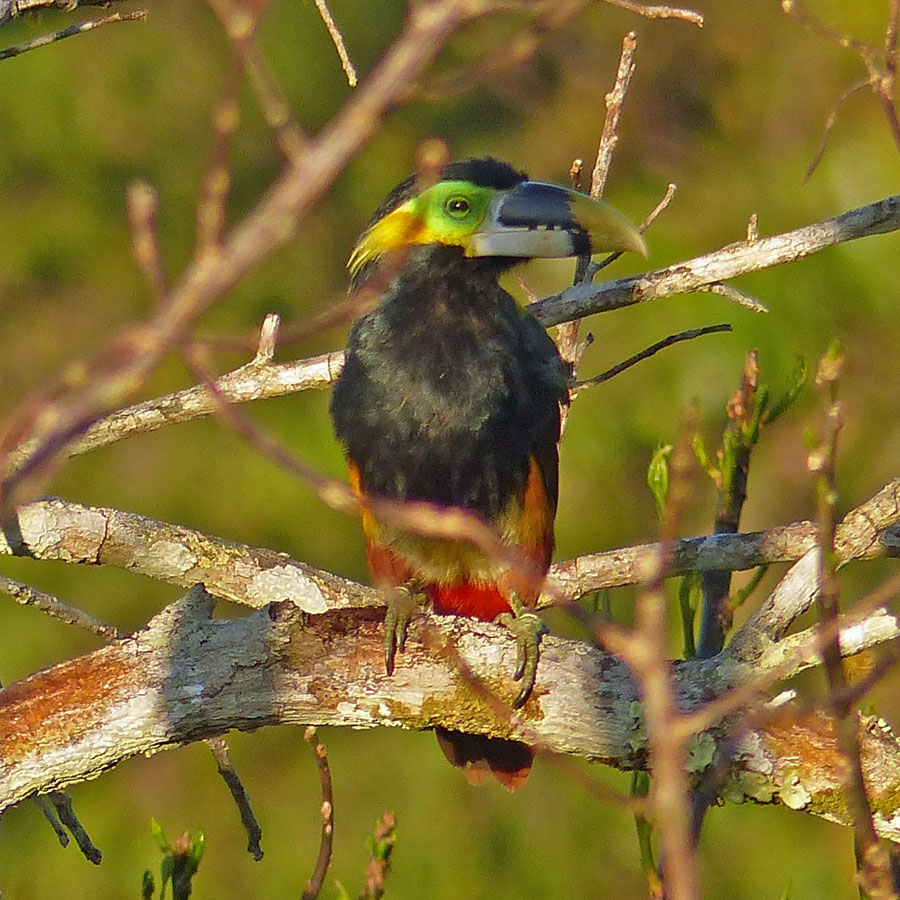
Toucanet, Guianan Selenidera piperivora
Description: The Guianan toucanet has green upperparts and tail. It has red under-tail coverts and a dark bill with dark red near its base. There are yellow ear coverts and an orange hind-collar. The male has a black cap and black underparts with lighter flanks. The female has a dark cap and grey underparts with lighter flanks. The Guianan toucanet is about 34 cm long.
Range: Northern South America in Brazil, French Guiana, Guyana, Suriname, and Venezuela.
Habitat: Tropical humid lowland forests.
Diet: Mainly fruits; also insects.
Conservation status: Least Concern.
Image by: 1) Manjith Kainickara 2, 3) Brandi KorteRange: Northern South America in Brazil, French Guiana, Guyana, Suriname, and Venezuela.
Habitat: Tropical humid lowland forests.
Diet: Mainly fruits; also insects.
Conservation status: Least Concern.

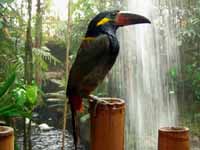
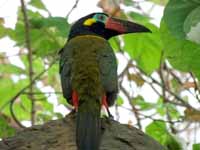
Toucanet, Spot-billed Selenidera maculirostris
Description: The spot-billed toucanet has a green back, tail, red under-tail coverts, relatively smalll grey bill with large tooth-like dark spots, and a yellowish hind-collar. The male has a black cap, black underparts with yellow flanks, and yellow ear coverts. The female has a chestnut cap and chestnut underparts with yellow flanks. The spot-billed toucanet is 34 cm long.
Range: Argentina, Brazil, Paraguay.
Habitat: Woodlands from primary forest to palm groves.
Diet: Fruits, insects.
Conservation status: Least Concern.
Image by: 1) Marcel Holyoak - Brazil 2) Tude e Joao 3) Carlos_Henrique - Brazil 4) Jairmoreirafotografia Range: Argentina, Brazil, Paraguay.
Habitat: Woodlands from primary forest to palm groves.
Diet: Fruits, insects.
Conservation status: Least Concern.
1) Pair 2) Female 3, 4, 5) Male
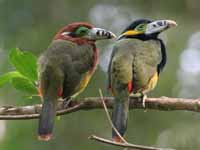
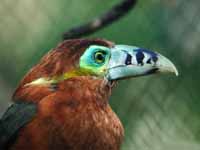
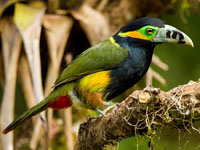

Toucanet,_Tawny-tufted Selenidera nattereri
Description: The male tawny-tufted toucanet has mainly green upperparts. It has yellow cheeks, pale blue skin around the eyes, and yellow behind the eyes. There are black underparts and a yellow rump. The female is similar to male but has black replaced by rufous. The tawny-tufted toucanet is about 32 cm long.
Range: Amazon Basin of Venezuela, Brazil, eastern Colombia and western Guyana.
Habitat: Forests and woodlands, preferring to be near streams.
Diet: Fruits; probably insects.
Conservation status: Least Concern.
Image by: 1) Nick_Athanas - Columbia 2) Alan_LewisRange: Amazon Basin of Venezuela, Brazil, eastern Colombia and western Guyana.
Habitat: Forests and woodlands, preferring to be near streams.
Diet: Fruits; probably insects.
Conservation status: Least Concern.

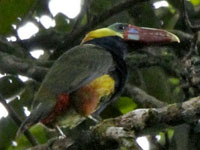
Toucanet,_Tepui Aulacorhynchus whitelianus
Description: The Tepui toucanet has mainly green plumage and a green rump. It has a black bill with varying amounts of red and a thin white base. The tail is sometimes red-tipped. The Tepui toucanet is up ot 41 cm long.
Range: Northern South America, in the vicinity of Guiana.
Habitat: Mossy forests, usually above 740 meters.
Diet: Fruits and probably insects also.
Conservation status: Least Concern.
Image by: 1) Thiago_Laranjeiras - VenezuelaRange: Northern South America, in the vicinity of Guiana.
Habitat: Mossy forests, usually above 740 meters.
Diet: Fruits and probably insects also.
Conservation status: Least Concern.
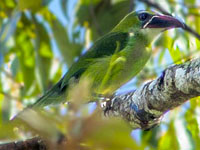
Toucanet, Yellow-eared Selenidera spectabilis
Description: The yellow-eared toucanet has green upperparts including the tail. It has a yellowish upper-bill and dark lower-bill. There is yellow ocular skin. It has black underparts, yellow flanks, and red under-tail covert. The male has yellow ear-coverts and a black cap. The female has a chestnut cap. The yellow-eared toucanet is about 37 cm long which makes it a large toucanet.
Range: Central America to northwest Ecuador.
Habitat: Forests, forest edges, secondary forests. Adjacent fruit trees.
Diet: Mainly fruits; also insects.
Conservation status: Least Concern.
Image by: 1) Patko_Erika 2) Cathie Barren 3) Nick_Athanas - C0sta Rica 4) HarmonyOnPlanetEarth - PanamaRange: Central America to northwest Ecuador.
Habitat: Forests, forest edges, secondary forests. Adjacent fruit trees.
Diet: Mainly fruits; also insects.
Conservation status: Least Concern.
1, 2, 3) Female 4) Male

